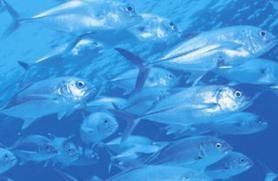Known for its heart health benefits, fish is an important part of our diets. Because fish is low in fat, high in protein and a rich source of omega-3 fatty acids, most of us should aim to eat between two to four servings of four to six ounces of fish per week. The U.S. Food and Drug Administration (FDA) also states that pregnant women, women who may become pregnant and women who are nursing can safely eat about 12 ounces of fish--about two average portions--per week, to help fill up on the good things fish can offer. This demographic should also steer clear of shark, swordfish, king mackerel, and tilefish, which are known to have high levels of mercury. Though fish is a nutritious food, we should be careful when choosing the types and amounts of fish we eat. Here's how to do it!
As we've mentioned before, larger fish who are higher on the food chain like tuna, sea bass and swordfish bioaccumulate toxins, like mercury. Eating excessive amounts of these fish may increase your mercury intake, for example, more so than eating a small whitefish like tilapia. And, your weight (and gender) also determine how much tuna you can have. For some of us, following the FDA's guidelines, and eating 12 ounces of tuna, could result in more mercury than is considered safe. So how can you tell where to draw the line?
Advertisement
The Environmental Working Group (EWG) has created a tuna calculator to help determine how much tuna you can safely eat in a week, even calculating how much albacore tuna (which has more mercury) you can eat versus how much "chunk light tuna" is safe. Though this is a good jumping off point for determining the right amount of tuna for your diet, keep in mind that there are many healthy fish options besides tuna. If you're concerned about the amount of mercury you're consuming, the FDA uses this mercury chart to determine average amounts of mercury in your favorite fish. The United States Environmental Protection Agency also provides consumption advisories to keep you up to date on the latest recommendations.
Overall, you want to eat as little mercury as possible, but because fish offers outstanding health benefits, it can be tricky to find a happy medium. Try sampling fish known to be lower in mercury like cod, salmon, haddock, herring and sardines.
When it comes to women of childbearing age and children under 5, be careful when choosing your seafood. Fish is one of the best sources of docosahexaenoic acid (DHA), a brainpower-boosting omega-3 fatty acid, that's important for pregnant women, breastfeeding women and even young children. To get enough DHA, women in this demographic should try eating fish like salmon and shrimp and avoid shark, tilefish, swordfish and king mackarel. They should also limit albacore tuna, which has more mercury per weight, to six ounces (one average meal) per week.
To learn more about kid-safe fish, read our post on finding safer seafood for your family.
Difficulty level: Easy
Advertisement
